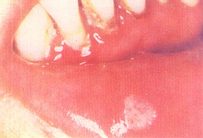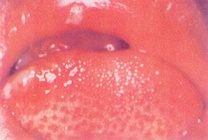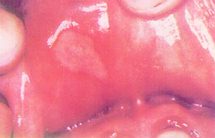| disease | Recurrent Aphthae |
| alias | Recurrent Aphthous Ulcer, Recurrent Oral Ulcer, Recurrent Aphthous Stomatitis, ROU, RAU, RAS |
Recurrent aphthae are the most prevalent type of oral mucosal disease, which can occasionally occur due to common colds, indigestion, mental stress, or depression. They commonly appear on the lips, cheeks, and edges of the tongue, and can occur on any part of the mucosa, but are rare on fully keratinized attached gingiva and hard palate. There is no age restriction, with the estimated onset age between 10 to 20 years, and it is more common in females. It can occur throughout the year, and the ulcers are self-limiting, usually healing within about 10 days. If aphthae frequently occur or appear in succession, it is referred to as recurrent aphthae. The lesions are ulcerative in nature, characterized by periodicity, recurrence, and self-limitation.
bubble_chart Etiology
The cause of the disease has not been fully clarified and may be multifactorial, possibly related to factors such as α-hemolytic L-type streptococcal infection, digestive system diseases, psychological factors, endocrine disorders, deficiencies in iron, zinc, folic acid, vitamin B12, and other substances, genetic factors, local injury, among others. Some also believe it is related to a low function of the fibrinolytic system. Currently, most scholars consider it to be an autoimmune disease.
bubble_chart Pathological Changes
It is a nonspecific inflammation. In the initial stage [first stage], severe vascular and inflammatory reactions occur, forming an ulcer, which is covered by a fibrinous pseudomembrane on the surface, with a small amount of necrotic tissue underneath. The lamina propria is heavily infiltrated with inflammatory cells, and collagen fibers may exhibit edema, hyaline degeneration, or fragmentation and disappearance. The lesions of periadenal aphtha are essentially the same as the above changes, but they are larger and deeper, with destruction of salivary gland acini, dilation of glandular ducts, and epithelial hyperplasia.
bubble_chart Clinical ManifestationsThe disease predominantly affects women aged 20 to 45, with a male-to-female ratio of approximately 2:3. According to relevant data, the incidence rate is not less than 10%. It often occurs in areas of the oral mucosa that are non-keratinized or poorly keratinized, such as the inner side of the lips, the tip of the tongue, the edges of the tongue, the underside of the tongue, the cheeks, the soft palate, and the vestibule.
1. Minor Aphthae: Initially, the affected area becomes sensitive or a pinpoint-sized or slightly larger congested area appears, which quickly develops into a shallow ulcer about 2-4 mm in diameter, round or oval, with clear boundaries. The center is slightly depressed and covered with a layer of pale yellow pseudomembrane. The surrounding mucosa is congested, forming a red halo, and the base is not hard to the touch. The number of ulcers is usually around 2-3. After the ulcers form, there is intense burning pain, especially at the tip of the tongue, which worsens when in contact with irritating foods. Generally, there are no systemic symptoms.
The ulcers usually heal on their own within about 7-10 days without leaving scars. However, they can recur after varying intervals. Long intervals can last 10-20 years or more; short intervals can be continuous, causing significant distress to the patient (Figure 1).

Figure 1: Minor Aphthae
2. Herpetiform Aphthae: Also known as stomatitis-type aphthae. This type is similar to minor aphthae except that the ulcers are smaller and more numerous (up to 20-30). The ulcers are scattered and widely distributed, with significant mucosal congestion. There is severe pain accompanied by headache, fever, and local lymphadenopathy (Figure 2).

Figure 2: Herpetiform Aphthae
3. Periadenitis Aphthae: Also known as recurrent necrotizing mucosal periadenitis or major aphthae, this is the most severe type. The ulcers usually occur singly, with two or more being rare. They commonly occur on the inner side of the lips and the corners of the mouth, but can also appear on the glossopalatine arch and soft palate. Initially, the ulcers are similar to minor aphthae, but they gradually enlarge to 1-2 cm in diameter and extend deep into the mucosal glands. The ulcers are purplish-red or dark red, with irregular edges that are raised like petals, and a central depression resembling a "crater." The base is uneven, slightly hard, and nodular. The surrounding redness is pronounced. There is severe local pain and possible systemic symptoms such as local lymphadenopathy and fever. The course of the disease often lasts more than a month, and in some cases, up to a year. Healing leaves scars, and severe cases can result in tissue defects or deformities (Figure 3).

Figure 3: Periadenitis Aphthae
4. Behçet's Syndrome: Also known as the triple symptom complex of eye-mouth-genitalia. This disease is a systemic condition characterized by recurrent oral, skin, genital, and ocular lesions, and can also affect joints, the cardiovascular system, and the nervous system.
Males are more frequently affected than females. Lesions appear successively or simultaneously in the mouth, eyes, and genitalia, and in some cases, only two areas are affected. The course of the disease can last for years or longer. Oral lesions manifest as minor aphthae or herpetiform aphthae, and periadenitis aphthae can also occur. Ocular lesions appear later and include conjunctivitis, keratitis, iridocyclitis with hypopyon, and retinochoroiditis, which can lead to blindness in severe cases. Genital lesions in females appear as ulcers on the labia majora, labia minora, and vagina, and in males on the glans, penis, or scrotum. Skin manifestations include folliculitis, erythema nodosum, and acne. Within 24-48 hours after pricking the skin with a sterile needle, papules or pustules often appear. This is a non-specific skin hypersensitivity reaction and has diagnostic value.
bubble_chart Diagnosis1. Minor aphtha commonly occurs in areas of the oral mucosa with poor keratinization. The ulcers are round or oval, varying in size and number, scattered in distribution, with neat edges, surrounded by erythema, and painful. They are self-limiting and have a history of recurrence. No scarring remains after healing.
2. Herpetiform aphtha ulcers are small and can number more than 20, widely distributed, without clustering or fusion. Patients experience pain and may have systemic symptoms such as headache and low-grade fever. No scarring remains after healing.
3. Major aphtha commonly occurs on the inner side of the lips and the corners of the mouth mucosa. The ulcers usually occur singly, are large and deep, resembling a "crater," with raised edges and a slightly hard, uneven base. The course is long, and scarring may remain after healing.
4. Behçet's syndrome: If oral, ocular, genital, and skin lesions have already appeared, diagnosis should be made in conjunction with an analysis of other systemic damages.
bubble_chart Treatment Measures
(1) Local Treatment The main purpose is to reduce inflammation, relieve pain, and promote ulcer healing. There are various treatment methods, chosen according to the condition:
1. Mouthwash: 0.25% Aureomycin solution, 1:5000 Chlorhexidine solution, 1:5000 Potassium Permanganate solution, 1:5000 Furacilin solution, etc.
2. Lozenges: Domiphen lozenges, Lysozyme lozenges, Chlorhexidine lozenges.
3. Powder: Borneol and Borax Powder, Xi Lei San, Indigo Powder, Nourishing Yin to Promote Tissue Regeneration Powder, Coptis Rhizome Powder, etc., are traditional Chinese medicines for treating oral ulcers. Additionally, compound formula Betamethasone powder also has anti-inflammatory, analgesic, and ulcer-healing effects.
4. Medicinal Membrane: The matrix contains antibiotics and cortisone. Before use, dry the ulcer area, cut a medicinal membrane close to the size of the lesion, and apply it to the ulcer to reduce pain, protect the ulcer surface, and promote healing.
5. Analgesics: 0.5-1% Procaine solution, 0.5-1% Dyclonine solution, 0.5-1% Dicaine solution, applied to the ulcer surface twice consecutively, used for temporary pain relief before eating.
6. Cauterization: Suitable for ulcers with few numbers, small areas, and long intervals. The method involves surface anesthesia with 2% Dicaine, isolating moisture, drying the ulcer surface, and applying a small cotton ball soaked with 10% Silver Nitrate solution, 50% Trichloroacetic Acid Tincture, or Iodophenol solution to the ulcer surface until it turns white. These agents precipitate proteins on the ulcer surface to form a thin membrane, protecting the ulcer and promoting healing. Care should be taken not to apply too much solution or cauterize adjacent healthy tissue.
7. Local Block: Suitable for periadenitis mucosa necrotica recurrens. Inject 0.5-1ml of 2.5% Prednisolone Acetate suspension mixed with 1ml of 1% Procaine solution into the tissue beneath the ulcer, once or twice a week, for a total of 2-4 times. This accelerates ulcer healing.
8. Laser Therapy: Helium-Neon laser irradiation can activate mucosal regeneration, reduce inflammatory response, and promote healing. The irradiation time is 30 seconds to 5 minutes per session, with no more than 5 lesions treated at once.
(2) Systemic Treatment Since the disease cause is still unclear, treatment effects are not ideal.
1. Immunosuppressants: Currently, the disease is considered related to autoimmune diseases. Immunosuppressants have been tried recently, showing some effect in certain cases. If confirmed as an autoimmune disease, immunosuppressants show significant efficacy. Commonly used drugs are adrenal corticosteroids: Prednisone 5mg/tablet, Dexamethasone 0.75mg/tablet, taken 3-4 times a day, one tablet each time. After 5 days of controlling the condition, reduce the dosage by 5-10mg daily. The total treatment course is 7-10 days, then stop. For long courses, to prevent infection spread, antibiotics should be added. For severe Behcet's syndrome, hospitalize and administer Hydrocortisone 100mg or Dexamethasone 5mg and Tetracycline 1g in 5-10% glucose solution intravenously, gradually reducing the dosage as the condition improves. Contraindicated or used with caution in patients with gastric ulcers, diabetes, or active pulmonary subcutaneous nodules.
2. Immunomodulators and Enhancers
(1) Levamisole: Used for those needing enhanced cellular immunity. Adults take 50mg three times a day for 2 days, then stop for 5 days, with a treatment course of 2-3 months. Common side effects include headache, dizziness, fatigue, joint pain, etc. A few cases may develop granulocytopenia, requiring regular blood tests during treatment.
(2) Gamma Globulin: Suitable for those with decreased humoral immune function. Intramuscular injection of one dose (3ml) during the acute phase of ulcers, with another 3ml injection after one week if necessary. Not suitable for long-term use, as excessive use can cause feedback inhibition of the body's immune response.
(3) Transfer Factor: Can transfer immune functions to an immunodeficient organism to restore its immune functions. Suitable for individuals with reduced or defective cellular immune functions. Contains 5×109 leukocyte extract per 1ml. Inject subcutaneously at sites with rich lymphatic return such as the armpit or groin. 1ml per dose, 1 to 2 times per week, 10 doses constitute one treatment course, generally one course is sufficient.
(4) Vitamins: Vitamin medications can maintain normal metabolic functions and promote the healing of lesions. During ulcer episodes, administer Vitamin C 0.1~0.2g three times a day, and one tablet of Vitamin B complex three times a day.
(5) Female Hormones: Estrogen can be cautiously used for women whose condition is related to the menstruation cycle. Take 0.1mg of Diethylstilbestrol once every night, starting from the 5th day after menstruation, for a total of 20 days.
(6) Trace Elements: For those with reduced serum zinc levels, supplementing zinc can improve the condition. Use 1% zinc sulfate syrup, 10ml each time, three times a day; or zinc sulfate tablets, 0.1g per tablet, one tablet each time, three times a day. Riboflavin derivatives, containing various vitamins, amino acids, trace elements, and some coenzymes essential for the human body, have certain effects on those with gastrointestinal diseases, promoting ulcer healing. Take 1g each time, three times a day, with no side effects, and can be taken for a longer period.
(7) Chinese Medicine Pattern Identification Treatment: For those with yin deficiency and effulgent fire, treatment should focus on enriching yin and clearing heat, using formulas such as Six-Ingredient Rehmannia Pill, All-Along Decoction, Sweet Dew Decoction, etc. For those with spleen and stomach latent fire, treatment should focus on clearing the stomach and purging heat, using formulas such as Stomach-Clearing Powder, Diaphragm-Cooling Powder, etc. Medications that invigorate blood and resolve stasis, such as compound formula Salvia tablets, can also be used to improve the condition.




